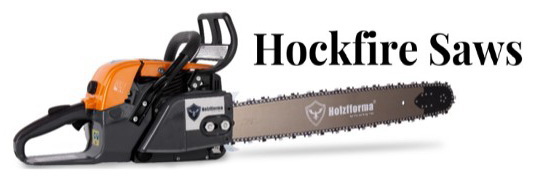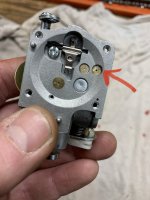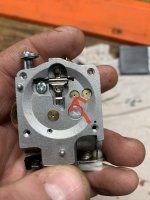Terry Syd
Pinnacle OPE Member
- Local time
- 5:39 AM
- User ID
- 575
- Joined
- Jan 18, 2016
- Messages
- 1,589
- Reaction score
- 5,987
- Location
- Comboyne, NSW Australia
My server has been down for more than three weeks, otherwise I would have posted earlier. I was writing this post in reference to Beaglebriar’s attempt to get my attention when the server went down. With me off-line for weeks, I had some extra time to expand on the post. -
I also dislike Walbros. I came to that conclusion when I decided to mod the HD-5 for use on my 64cc 029 – never modded a Walbro, it would be a good learning experience. Crikey, I ended up modding EVERY circuit, jet and air bleed hole in the carb, changed the metering spring and also blocked off two circuits and added another, it finally dialled in to be a strong running carb, but it still doesn't have the smooth idle like a Zama twin jet.
The Zama is a superior designed carb. Each function can be modded separately from the other functions. The idle screw simply changes the mixture of the idle, the twin jets can be drilled to change the low speed flow and tweaking the metering spring cleans up any throttle response issues.
The Walbro circuits affect each other. If you lean out the idle, you also lean out the transition/response and also the total low speed flow. Change one thing and you will be changing others, you can spend a lot of time and still end up with a compromise.
Further, the Zama has a superior designed idle circuit that ensures a more uniform mixture to the idle port.
It is worth noting the Husky factory engineers removed the HD-12 and put a modded Zama on their factory ported 372. Those engineers have access to dynos and a lot experience behind them to come to that decision. Significantly, they also incorporated a modded air filter on the saw, in other words, the Zama wasn’t the restriction in the intake tract, the air filter was the restriction. Most of these saws have inadequate air filters, if you want more top end flow then do a high speed check with the air filter on and one without the air filter. If you pick up some revs without the air filter, you may want to look into a different air filter.
I have a 365 with a ported 77cc BB kit on it, I run a modded Zama. Smooth idle, gobs of torque off the bottom, strong torque curve and it likes to cut around 12,000 - great work saw. It makes enough power that I didn’t bother with a high flow filter.
The biggest carb is not always the best carb. The function of the carb is to properly meter the fuel, if it has problems doing its basic function, then IMO it really isn't fit for that function.
I wish Mikuni made diaphragm carbs for saws, the Mikuni carbs for the boats and aircraft engines are designed far superior than the Zamas. However, a modded Zama twin jet is IMO the next best thing and that's what I would recommend. Perhaps Poleman is still modding Zamas that people send to him.
Which brings up another issue, the availability of the Zamas. The Chinese source has since dried up and the Zamas are getting more difficult to find. Perhaps the HD-12 can be modded for more performance. It appears that the air bleed/transition holes are in the ballpark, if so, then just a couple of extra mods should get the carb performing even stronger.
The first mod is to disable the EPA circuit from the main discharge tunnel to the low speed circuit. Several blokes on the forum are already doing this mod and could probably post some pictures. With the EPA circuit blocked off, then a 1mm hole needs to be drilled in the wet side to provide fuel to the low speed needle.
Then the next mod would be drilling the auxiliary jet to take it out from the stock size of .25mm to whatever works. If someone has already found the optimum jet size (say .35mm for a 71cc engine) that would save others from having to do some testing. If not, then if two HD-12s were modded in steps (.3mm test and compare, then .35mm in the next carb to compare to the .3mm, etc.) – Then finally shim the metering spring for throttle response and go cut wood.
RWJ
I’ve never worked on a RWJ, but it appears from the photo of the wet side that the carb doesn’t have the EPA circuit from the main discharge nozzle tunnel. Instead it has a separate ‘limiter’ jet on the idle/transition circuit. – To find out, if the low speed screw adjusts the flow from that jet, then it is a ‘limiter’ jet (ie: no matter how far out the screw moves, the maximum low speed flow is limited by the jet). In which case, I’d go big on the jet and just use the low speed screw to adjust the flow. (the ‘limiter’ jet is an EPA issue)
The extra jet feeding into the straight section of the carb appears to be an auxiliary jet, usually set at .25mm on Zamas and HDs. You can slowly open that jet up to increase the total low speed flow. However, it may not be necessary if you open up the ‘limiter’ jet on the idle/transition circuit and can get enough low speed flow.
Here’s where my lack of experience with the RWJ brings me unstuck, I don’t know how well the carb will idle. That’s the problem with the Walbro series that I referred to earlier – tweaking the low speed needle affects three things; idle, transition and total low speed flow.
It may be that opening the auxiliary jet a bit to get a bit more low speed flow and then not opening the low speed needle as far may be a preferred option – I don’t know.
Thanks to Ray Benson for finding this thread for me.
I also dislike Walbros. I came to that conclusion when I decided to mod the HD-5 for use on my 64cc 029 – never modded a Walbro, it would be a good learning experience. Crikey, I ended up modding EVERY circuit, jet and air bleed hole in the carb, changed the metering spring and also blocked off two circuits and added another, it finally dialled in to be a strong running carb, but it still doesn't have the smooth idle like a Zama twin jet.
The Zama is a superior designed carb. Each function can be modded separately from the other functions. The idle screw simply changes the mixture of the idle, the twin jets can be drilled to change the low speed flow and tweaking the metering spring cleans up any throttle response issues.
The Walbro circuits affect each other. If you lean out the idle, you also lean out the transition/response and also the total low speed flow. Change one thing and you will be changing others, you can spend a lot of time and still end up with a compromise.
Further, the Zama has a superior designed idle circuit that ensures a more uniform mixture to the idle port.
It is worth noting the Husky factory engineers removed the HD-12 and put a modded Zama on their factory ported 372. Those engineers have access to dynos and a lot experience behind them to come to that decision. Significantly, they also incorporated a modded air filter on the saw, in other words, the Zama wasn’t the restriction in the intake tract, the air filter was the restriction. Most of these saws have inadequate air filters, if you want more top end flow then do a high speed check with the air filter on and one without the air filter. If you pick up some revs without the air filter, you may want to look into a different air filter.
I have a 365 with a ported 77cc BB kit on it, I run a modded Zama. Smooth idle, gobs of torque off the bottom, strong torque curve and it likes to cut around 12,000 - great work saw. It makes enough power that I didn’t bother with a high flow filter.
The biggest carb is not always the best carb. The function of the carb is to properly meter the fuel, if it has problems doing its basic function, then IMO it really isn't fit for that function.
I wish Mikuni made diaphragm carbs for saws, the Mikuni carbs for the boats and aircraft engines are designed far superior than the Zamas. However, a modded Zama twin jet is IMO the next best thing and that's what I would recommend. Perhaps Poleman is still modding Zamas that people send to him.
Which brings up another issue, the availability of the Zamas. The Chinese source has since dried up and the Zamas are getting more difficult to find. Perhaps the HD-12 can be modded for more performance. It appears that the air bleed/transition holes are in the ballpark, if so, then just a couple of extra mods should get the carb performing even stronger.
The first mod is to disable the EPA circuit from the main discharge tunnel to the low speed circuit. Several blokes on the forum are already doing this mod and could probably post some pictures. With the EPA circuit blocked off, then a 1mm hole needs to be drilled in the wet side to provide fuel to the low speed needle.
Then the next mod would be drilling the auxiliary jet to take it out from the stock size of .25mm to whatever works. If someone has already found the optimum jet size (say .35mm for a 71cc engine) that would save others from having to do some testing. If not, then if two HD-12s were modded in steps (.3mm test and compare, then .35mm in the next carb to compare to the .3mm, etc.) – Then finally shim the metering spring for throttle response and go cut wood.
RWJ
I’ve never worked on a RWJ, but it appears from the photo of the wet side that the carb doesn’t have the EPA circuit from the main discharge nozzle tunnel. Instead it has a separate ‘limiter’ jet on the idle/transition circuit. – To find out, if the low speed screw adjusts the flow from that jet, then it is a ‘limiter’ jet (ie: no matter how far out the screw moves, the maximum low speed flow is limited by the jet). In which case, I’d go big on the jet and just use the low speed screw to adjust the flow. (the ‘limiter’ jet is an EPA issue)
The extra jet feeding into the straight section of the carb appears to be an auxiliary jet, usually set at .25mm on Zamas and HDs. You can slowly open that jet up to increase the total low speed flow. However, it may not be necessary if you open up the ‘limiter’ jet on the idle/transition circuit and can get enough low speed flow.
Here’s where my lack of experience with the RWJ brings me unstuck, I don’t know how well the carb will idle. That’s the problem with the Walbro series that I referred to earlier – tweaking the low speed needle affects three things; idle, transition and total low speed flow.
It may be that opening the auxiliary jet a bit to get a bit more low speed flow and then not opening the low speed needle as far may be a preferred option – I don’t know.
Thanks to Ray Benson for finding this thread for me.









